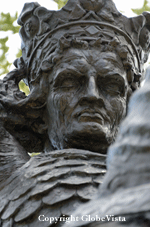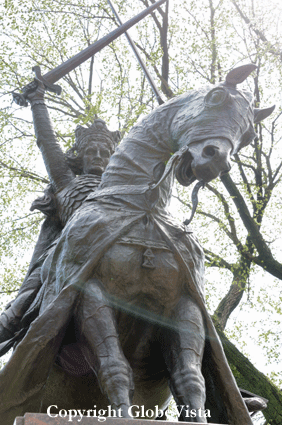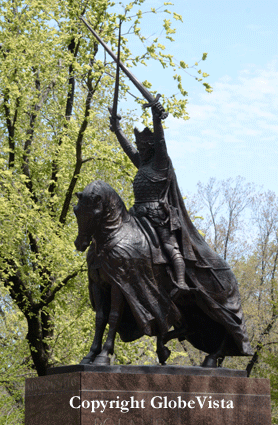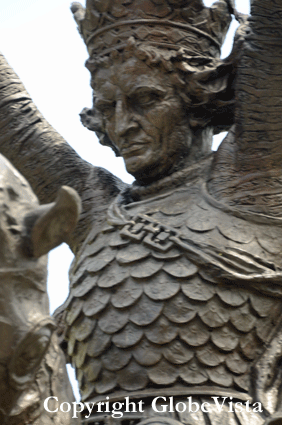King Jagiello Monument

Public Art: King Jagiello Monument
Sculptor: © Stanisław K. Ostrowski (1879-1947)
Architect: Aymar Embury II (1880–1966) designed the granite pedestal
Description: The bronze statue is of King Jagiello (c. 1351/1362 – 1st June 1434) on his mount, standing in his stirrups, holding two crossed swords above his head. The detail in the sculpture is extraordinary, most notably the veins protruding from the horse’s legs.
The king is depicted in light mail armor (with scales), cape and crown, with his swords, raised high. The cape that flows from the neck of the king is inscribed with heraldic emblems of Poland (eagle) and Lithuania (horserider).
The horse is depicted in a caparison, a decorative cloth cover. The caparison flows into the cape of the king. His head is lowered, mouth open and tilted to one side, I assume to not obscure the king. The horse’s legs dig into the ground as though coming to a sudden halt.
The monument commemorates the Battle of Grunwald in which King Jagiello was handed the two swords, following the victory over his of his enemy, the Teutonic Knights of the Cross.

Date Unveiled: Unveiled on the 15th of July, 1945 by count Józef Kazimierz Krasicki. Sculptor Stanisław K. Ostrowski was in attendance.
Location: The King Jagiello Monument can be found in Central Park, between Turtle Pond and the 79th Street entrance, New York City, New York, USA.
Inscription:
Wladyslaw Jagiello
King of Poland
Grand Duke of Lithuania
1386-1434
Founder of a Free Union of the
Peoples of East-Central Poland
Victor over Teutonic
Aggressors at Grunwald
July 15-1410
Background to the King Jagiello Monument: The King Jagiello Monument is a replica of a Jagiello memorial in Warsaw. The sculptor, however, added his own touch by including the crossed swords.
The monument was created for temporary display at the 1939 New York World Fair as Poland had a pavilion at the Hall of Nations. The statue took pride of place at the entrance of Flushing Meadows-Corona Park (Queens), with the single word POLAND carved into the pedestal.
Stanisław K. Ostrowski traveled to Carrara and Viareggio in Italy to create the 12ft bronze in the lost-wax method. On completion, it was shipped from Livorno to New York.
During the World Fair, Polish ambassador Count Jerzy Potocki proclaimed during the dedication ceremony in front of the statue “Over this miniature Poland with its story of peaceful pursuits and achievements, there stands on guard the symbol of armed might which once before saved Poland from an armed invasion. It is a symbol the lesson of which is understood today and will remain many, many years after the Polish Pavilion and the New York World’s Fair has receded into a distant memory.”
The irony of this statement would become clear when on the 1st of September, 1939, German and Russian armies invaded Poland. Marking the start of World War II.
The statue would never return to its homeland.

Three weeks after the invasion, Poland fell and the Nazis removed all symbols of Polish nationalism. The statue of King Jagiello, that Stanisław K. Ostrowski had based this monument on, was torn down and melted into ammunition.
In New York, the pavilions of Poland and Czechoslovakia were in disarray and eventually closed. Interestingly, Germany was the only major world power who didn’t have a pavilion at the World Fair, siting money woes. Following the invasion of Poland, the USSR Pavilion was also dismantled.
The outbreak of World War II meant that many Europeans working at the World Fair were stranded in the US and so too all the exhibits. The Polish Government, who was now in exile in England, sold the 600 artifacts showcased at their pavilion to the Polish Museum of America (Chicago). The one big problem remained, what to do with the King Jagiello Monument?
Like a knight in shining armor, the mayor of New York Fiorello LaGuardia campaigned to have the statue placed in New York’s Central Park. After raising $60,000 the King Jagiello Monument was unveiled on the 15th of July, 1945, on the 535th anniversary of the Battle of Grunwald (and also 2 months after Victory in Europe Day).
The pedestal with the simple word POLAND was replaced with a Milford pink granite pedestal that reads:
ERECTED BY THE CITIZENS OF FORT HAMILTON IN MEMORY OF OUR MEN WHO
DIED IN THE WORLD WAR AND IN HONOR OF THOSE WHO ANSWERED THEIR
COUNTRY’S CALL
A sad footnote to this story. The sculptor, Stanisław K. Ostrowski was one of the many stranded in New York, following the outbreak of World War II. He could only watch on from a distance as his country was left in ruins. His great desire was to return to Poland to help rebuild his beloved city of Warsaw. He even offered his services as an artist once the war had ended. Unfortunately, Stanisław died in Queens, New York on May the 13th 1947, in relative obscurity, alone and financially ruined. He was 68.
Who Was King Jagiello? With the statue steeped in so much history and drama, we can be forgiven for forgetting the true subject, King Jagiello.
King Jagiello (c. 1352/1362 – 1 June 1434) was the Grand Duke of Lithuania, who united Lithuania and Poland by marrying the Queen of Poland (who was 11) in 1386 and becoming king.
The marriage was a strategic one. He chose to wed the young Queen Jadwiga of Poland to neutralize dangers posed by armed incursions aka Teutonic Knights and to gain fertile lands. In order to marry, Jagiello promised to convert to Christianity (among other things).
Jagiello officially became a Catholic on the 15th February 1386 after being baptised in Wawel Cathedral in Kraków. The nuptials proceeded three days later and Jagiello was crowned King Władysław. Interestingly, Jagiello, ever the strategist, was also adopted by his wife’s mother, Elizabeth of Bosnia. This protected him against the unlikelihood of his wife’s death. There was no way the king was going to lose his crown.
Władysław II Jagiello and Queen Jadwiga reigned as co-monarchs. However, the Teutonic Knights saw through his “fake” baptism and continued their crusade.
Jagiello’s long term plans came to a grinding halt in 1399 when his wife and their newborn baby died. A sole ruler with no heir didn’t sit well. His counter plan was to re-marry. He chose Anna of Celje, the granddaughter of Casimir III of Poland.
Meanwhile, the king and the Teutonic Knights continued their spiteful battles. It all came to a head in 1410 when the king advanced into the Teutonic heartland. Armed with an army of nearly 40,000 men they virtually annihilated the Teutonic Order’s army. It would be known as the Battle of Grunwald, one of the largest and most ferocious battles of the Middle Ages.
The monument to King Jagiello depicts him in this battle.
In 1416 Anna of Celje died leaving the king with a daughter. He married again, and she too died without bearing him a child. His 4th wife, Sophia of Halshany, gave birth to two sons. Deals were done and concessions made following the death of King Jagiello’s only daughter so that his two young sons could become rightful heirs to the throne. In 1434 the king died from a cold. His eldest son became King of Poland and his youngest, King of Lithuania.

References: IN THE FOOTSTEPS OF STANISŁAW K. OSTROWSKI, 1879-1947. (From the Series of Silhouettes of Polish Artists in the U.S.A.) by JADWIGA IRENA DANIEC.
Secrets of Manhattan (blog), The Polish King in Central Park, by Steve Madeja, June 2, 2017.